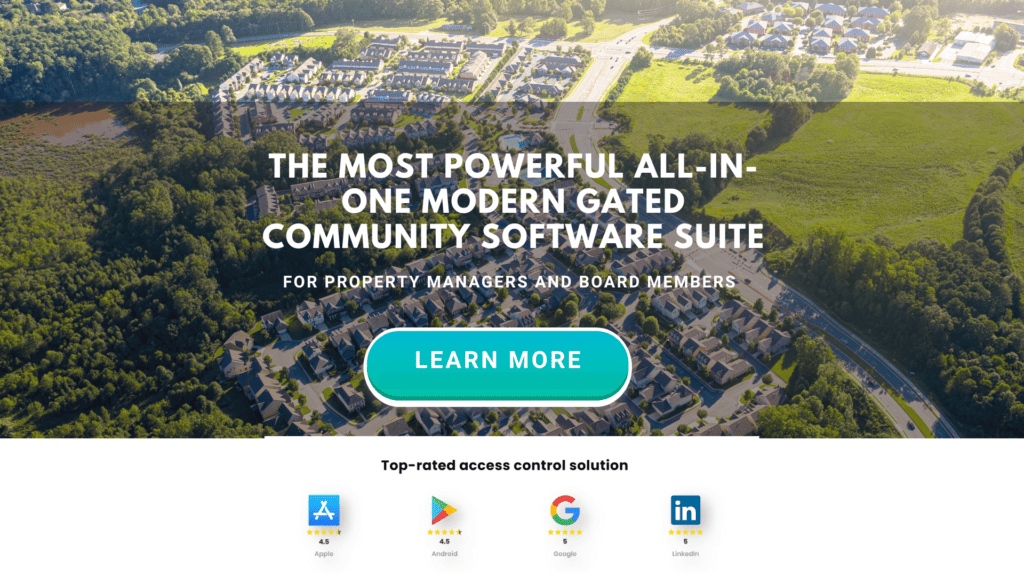From juggling the diverse needs of residents to adopting new technologies without disrupting daily life, HOAs face challenges that require thoughtful solutions. Access management is critical for maintaining security while ensuring residents, visitors, and service providers can move freely and conveniently. Yet, the process isn’t always straightforward.
This article examines the unique hurdles HOAs encounter when managing access in multi-residence communities. We’ll explore practical strategies and innovative tools to help HOAs overcome these challenges and deliver a secure, efficient, and resident-focused access experience.
IN THIS ARTICLE
Challenges in Access Management for HOAs
Managing access in HOAs is a balancing act. These communities host a diverse group of users—homeowners, tenants, guests, contractors, and delivery personnel—each with unique access needs.
The challenge lies in maintaining robust security while ensuring everyone has the appropriate level of access at the right time. This complexity is amplified in multi-residence communities, where multiple entry points and shared amenities add layers of logistical considerations.
Here’s a closer look at some of the most common challenges HOAs face when managing access:
1. Balancing Security with Convenience
HOAs must strike a delicate balance between ensuring the community remains secure and not making access frustrating or overly complicated for residents and visitors. For example:
- Residents may become irritated with cumbersome entry procedures, leading to workarounds like propping open gates or sharing codes, which can compromise security.
- Visitors and service providers often struggle with access codes or manual approval processes, causing delays and frustration.
2. Handling Multiple Access Points
Managing multiple entry points—such as main gates, parking lots, lobbies, elevators, and shared spaces like pools or gyms—can be overwhelming in larger communities.
Each access point has different requirements, and inconsistent management can result in uncoordinated security efforts across the property or gaps in coverage could leave certain areas vulnerable
3. Visitor and Vendor Management
Temporary access for guests, contractors, and delivery personnel is a recurring challenge. HOAs must ensure these individuals can enter the property without compromising security. Common issues include:
- Access codes are being shared or reused, allowing unauthorized individuals to enter.
- Inefficient processes that require manual intervention cause unnecessary delays.
4. Integrating New Technologies with Legacy Systems
Many HOAs rely on older access control systems that may need to support integration with modern solutions like Bluetooth door access or cloud-based platforms. Upgrading these systems can be costly and complicated, leaving some communities hesitant to adopt new technologies.
5. Addressing Resident Concerns
Residents are at the center of any HOA, and their needs and concerns play a critical role in access management decisions. Key issues include:
- Privacy concerns over how data from access logs is collected, stored, and used
- Frustration with new systems that may have a learning curve, especially for elderly or less tech-savvy residents
- Accessibility challenges for individuals with disabilities or mobility limitations
 Effectively managing access in HOAs requires understanding these challenges and developing tailored strategies to address them. By identifying specific pain points, HOAs can implement solutions that balance security, convenience, and resident satisfaction.
Effectively managing access in HOAs requires understanding these challenges and developing tailored strategies to address them. By identifying specific pain points, HOAs can implement solutions that balance security, convenience, and resident satisfaction.
Solutions for HOA Access Management
Despite these challenges, some effective strategies and technologies can help HOAs streamline access management while addressing security concerns. Below are practical solutions tailored to meet the diverse needs of residential communities.
1. Implement User-Friendly Access Control Systems
Modern access control systems prioritize convenience without sacrificing security. Features like Bluetooth door access and mobile authentication allow residents to unlock gates, doors, and shared spaces using their smartphones, eliminating the hassle of physical keys or cards.
Some of the key benefits are:
- Convenience: Enables seamless, contactless entry across all access points.
- Visitor management: Guests can be issued temporary digital credentials through mobile apps, ensuring secure and time-limited access.
- Compatibility: Integrates effortlessly with existing infrastructure, providing a consistent and unified solution.
These systems also streamline access for visitors, reducing manual interventions by staff or residents.
2. Centralize Access Management
A centralized, cloud-based platform simplifies the oversight of multiple entryways, allowing property managers to control and monitor all access points from a single interface. Real-time updates and data logs improve operational efficiency and provide enhanced security.
When deciding on a platform, look for things like:
- Centralized dashboard: Manage access for residents, guests, and vendors efficiently from one platform.
- Real-time updates: Issue, modify, or revoke access permissions instantly, minimizing delays.
- Comprehensive logs: Generate detailed reports of all entry and exit activities for audits or investigations.
3. Streamline Visitor and Vendor Access
Managing visitors and vendors effectively is critical to maintaining both convenience and security. Advanced tools like License Plate Recognition (LPR) systems and pre-registration processes can help simplify entry for authorized individuals.
Modern solutions include features like:
- Pre-registration: Residents can authorize guests via a mobile app, granting them temporary credentials such as QR codes or license plate registrations.
- Smart gate systems: Use LPR technology to automate vehicle access for pre-registered visitors, reducing manual checks at gates.
- Time-limited access: Ensure visitor credentials are automatically deactivated after their authorized period to prevent unauthorized entry.
4. Integrate Modern Technology Incrementally
Upgrading legacy systems doesn’t need to disrupt daily operations or strain budgets. HOAs can gradually incorporate modern technologies like Bluetooth door access or virtual guard systems into their security infrastructure by adopting a phased approach.
Start by upgrading high-traffic or high-priority areas, such as main gates or building entrances. Gradually expand to include shared amenities, parking lots, or clubhouses. Work with vendors offering compatibility solutions, such as bridging modules, to connect modern tools with older systems.
5. Engage and Educate Residents
Introducing new access systems requires clear communication and support to ensure a smooth transition. Residents who feel informed and supported are more likely to embrace the changes.
Here are a few ideas for educating your community on the new tools:
- Host information sessions: Discuss the new system’s benefits and address concerns like data privacy or accessibility.
- Provide user guides: Offer simple instructions and troubleshooting resources to make adoption more manageable for all residents.
- Ensure accessibility: Include features or alternatives for less tech-savvy residents, such as phone support or physical credentials.
6. Use Data to Optimize Security
Modern access systems generate valuable data that can help property managers refine security and improve operational efficiency. Sophisticated tools can offer insights into things like:
- Traffic analysis: Identify peak usage times and adjust security protocols to match.
- Anomaly detection: Spot irregular access attempts, such as repeated failures or after-hours entries, and respond proactively.
- Resource allocation: Use data to optimize staffing schedules or prioritize maintenance based on usage trends.
Analyzing access patterns allows for smarter decision-making and closes any security gaps that you might have overlooked.
7. Plan for the Future
HOAs must adopt scalable, forward-thinking solutions to remain effective as technology evolves. Systems that integrate with smart home devices, Internet of Things (IoT) technologies, or biometric authentication ensure the community remains adaptable to future needs.
- Scalability: Easily add new buildings, gates, or amenities without requiring a complete system overhaul.
- IoT integration: Link access points to other smart devices for a more connected experience (e.g., lights or HVAC systems responding to entry events).
- Biometric options: Incorporate touchless options like facial recognition or fingerprint scanning for enhanced security and hygiene.
Conclusion
Effective access management is essential for creating a safe, welcoming, and functional environment in HOA communities. It involves addressing various challenges, from balancing security with ease of use to handling multiple access points and ensuring resident concerns are heard.
By tackling these issues head-on, HOAs can develop systems that protect their communities and enhance residents’ daily lives.
Modern technologies like Bluetooth door access, cloud-based platforms, and LPR systems simplify operations and elevate the resident experience. When paired with thoughtful planning, gradual system upgrades, and transparent communication, these tools can turn access management into a streamlined, reliable process tailored to the needs of any community.
Want to simplify access management and enhance security for your HOA? Let’s create a system that fits your community’s unique needs. Contact Proptia today to explore innovative, easy-to-use solutions that make life easier for residents, staff, and visitors.

